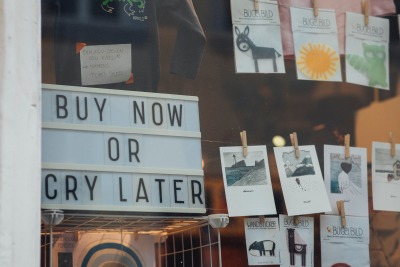5 Ideas to Promote Your Retail Business When Consumer Spending is Down
When checking your reports and noticing a decline in sales for your store, it can feel overwhelming. With so many factors influencing sales, trying to find solutions can be disheartening and trying to wait it out can feel like the easiest thing to do.
But there are solutions. Even in times of reduced consumption, it's possible to encourage growth. Here are a few of Epos Now’s tips for marketing your products to more hesitant customers.
1. Build a presence in new places
Consumers buy your products to meet their needs or desires. The first business they find that they feel is capable of filling that need will win their custom. This means that researching where to market, and marketing widely, can bring excellent returns on investment if it helps your store put itself at the front of a customer's mind.
Many consumers’ first look at a product or service happens online these days. The prevalence of webrooming (researching a product online and buying in-store) and showrooming (researching in-store before buying online) reflect the close relationship between the eCommerce and high-street worlds.
The statistics on these trends are pretty clear. 88% of internet users (and who doesn’t use the internet these days?) say they have done online research before buying products in-store[1]. The same poll found that 76% of consumers bought online after learning about products in stores.
These trends mean the ideal marketing strategies will explore both avenues to reach potential customers in different ways. Businesses that haven’t yet, or aren’t suited to, eCommerce can still benefit from a website or blog, and local inventory advertising. They can also market on social media for next to no cost at all.
Advertising your products online has never been so easy with Epos Now’s NearSt integration:
- Let people nearby know you have what they’re looking for with easy-to-use local inventory advertising
- Advertise on Google, Facebook and Instagram whenever customers search for terms related to your products, so none of your advertising budget goes to waste
- Synchronise NearSt with Epos Now so that you control which products get maximum exposure and who you want to target with your marketing

2. Try physical advertising for more memorable marketing
While the internet remains at the forefront of many marketing strategies and provides many free avenues for retailers to exploit, physical advertising can be fruitful. While you may reach fewer people and need to pay for the production of materials, a physical presence can have a more profound effect on those exposed to it.
This may be through physical advertising like billboards, but it could also include pop-up stalls, special events, and many other alternative forms of marketing. Customers that only engage with a business online can feel more distant. Something tangible, like mail-delivered leaflets, can help you have a physical presence in your customers’ lives.
3.Rebranding your product as essential
When your customers look to save money, their perception of your product and its importance to their lives can influence how much they continue to spend at your business.
Harvard Business Review theorises that customers think about purchases in four main ways: as essential “must-buys”, as occasional “treats”, as postponable “buy-laters”, and as expendable “non-necessities”[2]. Their four different kinds of consumers will reduce expenditure within those brackets differently:
- Slam-on-brake savers will cut out all expendable and postponable purchases while reducing the number of treats they indulge in to maximise their financial security.
- Pained-but-patient purchasers will cut out most expendables, delay some of their extra expenses and drop some of their regular treats.
- Comfortably-well-off consumers will drop some luxuries but will not forego many of their preferred products.
- Live-for-today livewires, the retailer's dream, will not want to reduce expendables and will spend whatever income they have. However, they may not expand into new areas of consumption.
 According to Harvard Business Review, these different kinds of consumer will respond in their own ways to your marketing. Nevertheless, companies selling less essential products will need to fight to retain custom for each of these customers when times are hard.
According to Harvard Business Review, these different kinds of consumer will respond in their own ways to your marketing. Nevertheless, companies selling less essential products will need to fight to retain custom for each of these customers when times are hard.
Combatting this means repositioning the business within the market, which doesn’t necessarily mean changing the product itself. What it really means is rebranding or adjusting the marketing strategy to highlight the product's relationship to an essential need in the consumer’s life.
Even luxury items will have time-saving, stress-reducing, or convenient qualities. Focusing marketing materials on such aspects of the product can cause customers to reconsider whether your product is one they ought to cut out of their purchasing habits.
4. Build a sense of urgency with limited-time offers
Your customers don't just think about savings in terms of not making purchases. Even if your product gets thought of as non-essential, it will still be considered in terms of value, and perceived value is something you can influence.
While consumers might be prioritising other purchases, a tactic you can employ might utilise the benefits of a limited-time promotion campaign. Such a campaign refocuses the customer away from the actual price of the purchase to the difference between the sale and non-sale prices. The effect created breaks down the distinction between buying and saving because your customer makes savings whether they buy the product or not.
Psychology Today published a study of limited-time offers assessing the factors influencing their success and how they work[3]. Choosing when an offer should end has a crucial impact, and a business’s market position can change how short it should be.
The takeaways from the study suggest:
- Well-known brands suit shorter offers that increase “anticipatory regret” at missing out.
- Smaller businesses that try to emulate this can inspire a “burden of inconvenience” that can lead to customers rejecting the offer.
- Psychologists believe including a reason for the offer can counteract the burden of inconvenience, creating a sense of inclusion and can increase the offer's attractiveness.
- Anticipatory regret seems to be a more potent commercial force than curiosity or interest in a product, suggesting that “don’t miss out” messaging can push consumers into making purchases.
5. Use opportunities to advertise cheaply
Staying in contact with hesitant customers can be an effective way of guiding them back to your store, and this becomes critical during difficult times.
Those customers that have read an email newsletter or seen a post about your staff hard at work will feel more connected to the business. As a result, they will be more reluctant to cut out purchases from your store.
CRM (customer relationship management) can have a big impact when employed alongside regular marketing. In fact, it can boost customer retention by a whopping 27%, with a 29% sales increase[4].
These statistics demonstrate that consumers do prefer businesses that communicate regularly and build their brand directly, with attention paid to the individual customers themselves.
It's with these parts of trade where a well-equipped EPOS system comes into its own. Email marketing can be made much simpler with a Mailchimp integration which helps you construct the email quickly, then send it to a customer base stored on your EPOS and exported to this useful email-writing software. This way, CRM tasks like a monthly newsletter take much less time to complete.
Newsletters go out to all those customers that have consented to receive them, even if they've stopped coming through the door. Keeping less frequent visitors informed about offers, promotions, new faces at the business and other exciting developments can rebuild relationships and inspire customers to come back more often.
Posting on social media can also communicate a lot of similar information that expresses the human, relatable side of your business. When connected to the daily life of your store, customers considering whether or not they want your products don’t just think about a faceless business; they think about you, your team, and everything they’ve read about you.
Want to find out more about ways Epos Now can help you promote your products? Submit your information below to speak to a member of our team
